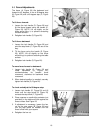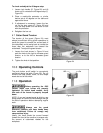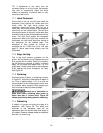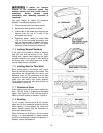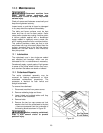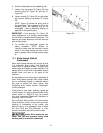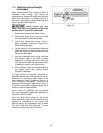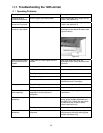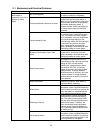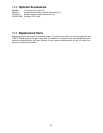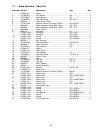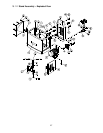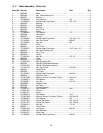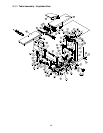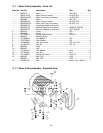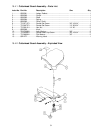
24
13.2 Mechanical and Electrical Problems
Trouble Probable Cause Remedy
Machine will not
start/restart or
repeatedly trips circuit
breaker or blows
fuses.
No incoming power.
Verify unit is connected to power, and
on-switch is pushed in completely.
Overload automatic reset has not reset.
When jointer overloads on the circuit
breaker built into the motor starter, it
takes time for the machine to cool down
before restart. Allow unit to adequately
cool before attempting restart. If
problem persists, check amp setting on
the motor starter inside the electrical
enclosure.
Jointer frequently trips.
One cause of overloading trips which
are not electrical in nature is too heavy
a cut. The solution is to take a lighter
cut. If too deep a cut is not the problem,
then check the amp setting on the
overload relay. Match the full load amps
on the motor as noted on the motor
plate. If amp setting is correct then
there is probably a loose electrical lead.
Check amp setting on motor starter.
Building circuit breaker trips or fuse
blows.
Verify that jointer is on a circuit of
correct size. If circuit size is correct,
there is probably a loose electrical lead.
Check amp setting on motor starter.
Motor starter failure.
If you have access to a voltmeter, you
can separate a starter failure from a
motor failure by first, verifying incoming
voltage at 230+/-20 and second,
checking the voltage between starter
and motor at 230+/-20. If incoming
voltage is incorrect, you have a power
supply problem. If voltage between
starter and motor is incorrect, you have
a starter problem. If voltage between
starter and motor is correct, you have a
motor problem.
Motor overheated.
Clean motor of dust or debris to allow
proper air circulation. Allow motor to
cool down before restarting.
Motor failure.
If electric motor is suspect, you have
two options: Have a qualified electrician
test the motor for function or remove the
motor and take it to a qualified electric
motor repair shop and have it tested.
Miswiring of the unit.
Double check to confirm all electrical
connections are correct and properly
tight. The electrical connections other
than the motor are pre-assembled and
tested at the factory. Therefore, the
motor connections should be double
checked as the highest probability for
error. If problems persist, double check
the factory wiring.
On/off switch failure.
If the on/off switch is suspect, you have
two options: Have a qualified electrician
test the switch for function, or purchase
a new on/off switch and establish if that
was the problem on changeout.



